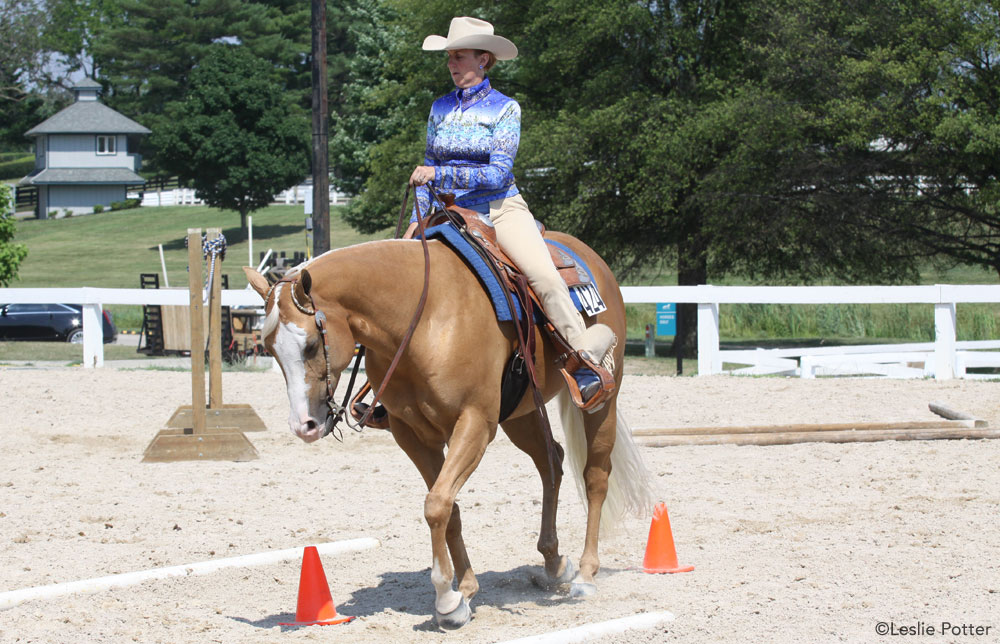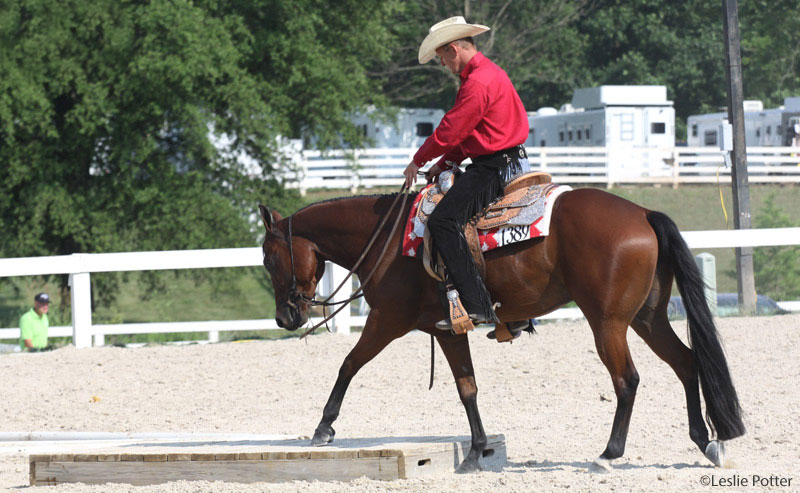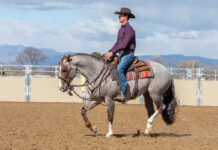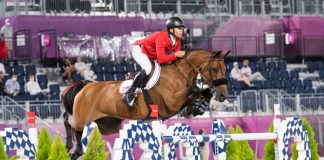Performing in trail classes sounds so easy — after all, you aren’t actually out on the trails battling wild creatures and dangerous ditches or fallen trees. You’re riding in a nice, safe arena, on soft footing and around contrived obstacles. And the obstacles — a bridge, poles, gates and cones — seem so unimposing. How much skill could such a class involve?

As a matter of fact, with today’s courses focused on technical difficulties and less on dangerous or fearful maneuvers, you’ll need a high level of riding skill if you want to ride out with a blue. While competitors’ abilities do vary, you’ll see that winning riders have spent endless hours honing their communication with their horses and perfecting the small details many overlook as unimportant.
But this doesn’t mean you can’t take home your share of awards. If your horse has the course basics down, you can polish your performance to a winning shine by following these tips from LaRae Fletcher-Powell.
Queen of the Trail
With four Canadian and three U.S. National Championships in trail, LaRae Fletcher-Powell is a dominant, international force in Arabian trail classes. It is not uncommon for this Auburn, Washington, trainer to arrive at a regional show with as many as 15 horses in tow and end up filling most of the top-10 slots. And while she is the undisputed queen of the trail class with the Arabian breed, like many successful performance trainers, LaRae wears more than one hat.
But she doesn’t just switch off between Stetsons and hunt caps. When she’s not taking the ribbons home to her training facility, Silver Aspen Ranch, she’s the one doing the pinning — as a rated judge for both Arabians and Appaloosas. Her dual career gives her an edge in both: As a competitor, she has a more thorough understanding of how to avoid inadvertently falling into disfavor with judges. As a judge, she has not only a deeper empathy for exhibitors, but a more watchful eye when scoring their performances.
From this bifocal perspective, LaRae has gained some valuable insight into how riders can improve their trail scores through subtle showmanship and equitation details. She knows firsthand that it’s the little things that separate the blues from the reds.
Trail classes have changed a lot since LaRae first began exhibiting at the age of 6. “There aren’t as many hazardous obstacles, because show management is a lot more concerned with liability than they used to be,” she says. “The emphasis now is more on technical difficulty.”
Gone are the days of seesaw bridges and bear hides to drag past tethered billy goats. Most trail classes don’t even include the offside dismount and remount any more. What has taken their place is more complicated jog- and lope-over poles, narrower back-throughs and exacting gut changes. Arabian shows in particular have tended to err on the side of safety.
Competitors at Arabian shows have the advantage of being able to walk the course before the class starts. Any questions for the judge can be asked at that time, and this is a good opportunity to assess variables such as footing, spacing distances between poles, bridge height, the type of latch on the gate and so on. Like walking a cross-country course, this helps take some of the guesswork out of the performance.
The International Arabian Horse Association recently adopted judging standards for trail classes at national and regional levels, which removes some of the subjectiveness. LaRae was on the committee that established the new criteria and says it’s designed after the scoring system used for reining patterns: Each horse starts out with 70 points and gets automatic deductions for mistakes such as hitting a pole (-2 points), breaking gait (-5 points), refusing an obstacle or falling off the bridge (-10 points).
As in reining or dressage, a scribe fills out a scorecard of the judge’s verbal comments, so the judge never has to look away from the performance. Small inconsistencies that may have been missed under the previous system are more likely to be noticed. As a judge, LaRae appreciates the thoroughness the new system provides. And as a competitor, it makes attention to detail even more critical. Now more than ever, every point counts.

Types of Trail Class Obstacles
So how can you snag the most points with a consistently flawless winning impression? Listen up as LaRae walks the course with you and gives her tips for perfecting a trail-class performance.
The Bridge.
No matter how much you practice at home, the bridge at the show is bound to look, smell and sound differently. That is why it is imperative that a good trail horse move forward willingly, even if he is feeling a little suspicious. “He has to be willing to take your word for it,” says LaRae. “A step back is considered a refusal, so forward motion is really important. My horses know when I point them at something, they better be going toward it!”
That doesn’t mean judges want to see an animal who plods across with no interest in his surroundings. There is still room to score some subjective points in the area of style and expression. “I look for a horse who shows interest and expression, without being anxious,” says LaRae. “Ears up, looking where he is going, and willing.
But a horse who rushes the bridge will get into trouble. “You want the approach slow and rated, not fast, so he can pay attention to the angles of the ramp or the elevation of the step-up,” says LaRae. If the approach is too hurried, many riders will halt their horses before asking them to cross the bridge. Unless a hesitation is called for in the course description, LaRae considers this low-level cheating and has little patience for it. “It is irritating as a judge to see them stand there and dink around,” says LaRae. “As a competitor I know why they do it, but you should show continuity through the whole course, rather than stopping and starting.”
A horse who does not pay attention approaching the bridge can stumble, slip, drop a foot over the side or even fall off. In a trail class, this is an unforgivable faux pas.
“You fall off a bridge, you die,” says LaRae simply. She means this figuratively in the show ring, but in real life the situation can literally mean life or death. “If you have a historical understanding of where the obstacles in a trail class come from, it is pretty hard to justify recovering your score after coming off a bridge.”
Back-Through.
A horse that backs easily and moves off the rider’s leg aids should have no trouble negotiating this phase of the course, but LaRae sees a high degree of rider anxiety over this basic element. “People create a lot of problems themselves by getting nervous,” she says. “The horse picks up on that and starts to get antsy. Then the rider overcues and the horse’s hips start doing the hula, swinging left and right with every step.”
The trick to a clean back-through is to line the horse up straight at the beginning of the obstacle, then let him settle for a few seconds before asking him to back up. Ask for small, precise steps. LaRae warns that the most common mistake riders make is leaning over and looking down at the poles while backing up. This throws the horse off-balance and results in the horse backing the direction the rider is looking. “If a rider feels she has to look, stop the horse first, get your bearings, then ask for the back up. Even then, it should just be a glance.”
Sidepass.
The sidepass element can be combined with the back-through or stand alone as a separate obstacle. In either case, it is important to keep the pole aligned behind the rider’s heel and ahead of the back cinch. Unlike the back-through, it is necessary to look down while sidepassing, but LaRae cautions riders to look where they are going, not where they have been. “I don’t know why riders want to do this, but it is a sure-fire way to hit the poles,” says LaRae.
Judges want to see a smooth, fluid sidepass with a nice cross-over in front, but sometimes an obstacle won’t allow for so much movement. Sidepassing one side of a turn-around box, or negotiating part of a back-through that has scenery associated with it requires more precision. “Tighter obstacles call for smaller steps, so a horse has to know how to sidepass without crossing over, too,” LaRae points out. “In that case the horse has to be cautious and go slower — but don’t take forever.”
Gate.
“Most horses can work a gate, but it’s hard to score really high on this one,” says LaRae. So it comes down to showmanship. As a judge, I use this as one way to identify my top horses.” LaRae’s strategy is to use the gate as a showcase to really underscore how well-broke and obedient her horse is. Her first move is to sidepass two or three steps to get into position. This looks a little more polished than just riding up next to the gate.
Next, she makes it really obvious that her horse will stand quietly on a loose rein while she opens the latch. “As a judge, it really bugs me to see a horse who moves around while the rider is trying to open the gate, because on most ranches you need two hands to work the latch, and you can’t be trying to hold your horse still at the same time.”
After the latch is undone, LaRae negotiates the gate in whatever way is specified in the course design, pulling or pushing it open, and riding or backing through. She is careful to open the gate a little wider than necessary, to make sure her horse clears it without getting hung up. Once the gate is closed again, she finishes the obstacle by sidepassing away a few steps. “This just dresses it up a little more,” she explains, “And that way your horse won’t hit it with his butt as he turns.”
Cones.
Jogging through cones or poles is one of the easier requirements, but for that reason some people don’t pay much attention to it and subsequently lose points. Mistakes LaRae sees as a judge are riders who forget to keep their horses in a nice frame because they are concentrating on steering through the serpentine, or horses who break gait because riders ask them to turn too sharply. “Don’t oversteer,” she warns. “Keep your horse very slow and collected so he stays pretty. If you let him get strung out, he’s harder to steer.”
Another way to gain a point or two on the cones is to ask for nice, round turns, rather than just weaving in and out on a stiff-sided horse. “You want to keep a soft shoulder so you can push him around the cones a little,” says LaRae. “It looks a little prettier and shows a higher degree of training.”
Poles.
Poles can be elevated or on the ground, and the course designer will space them closer together for a walk- or jog-over, further apart for a lope-over. Lightly ticking a pole is usually not counted heavily against a competitor, but knocking a pole over or moving a ground pole is more serious. LaRae likes to see a horse walking or jogging the poles with a loose rein, giving the impression of doing it without much guidance. A lope-over, however, calls for more of a collected frame, with light contact.
“This is usually the class separator,” says LaRae. “Lope-over poles are getting much more technical and complicated. You see lots of fan patterns where you have to pick your spacing perfectly or you’ll hit poles, or cross-patterns where you have to lope in a circle. You need to have both timing and steering.”
To successfully negotiate lope-over poles, you must be able to accurately judge a horse’s length of stride. If the poles are arranged in a fan, shorter-strided horses should head for the section where the poles are closer together. Horses with longer strides should stay farther to the outside. Riders with hunter experience have a distinct advantage, because you need a good feel for your horse’s way of going and a good eye for judging distance on the ground. The approach is critical. If the first pole is gauged correctly, all a rider has to do after that is stay out of the way and guide the horse through the rest. If the approach is off, the horse must drop a stride, take an extra one, switch leads or hit poles.
To help riders understand the importance of being able to gauge the length of their horse’s stride, LaRae makes them lope the poles on foot.
A good way to learn to gauge the length of your horse’s stride is to practice at home. Count strides as you lope your horse over a single ground pole. Begin by counting from two strides away, and gradually increase the distance to four, five and then six strides away. Once you can accurately predict the distance between you and the pole, you can adjust your horse’s stride from several yards out so that he lopes over clean every time.
The Sum of Parts
Part of the trail-class allure is that courses are never the same. But the basic training elements needed to negotiate each obstacle never change. Practice, composure and attention to detail can make the difference between an also-ran and a shining star.






I love watching and riding trail class. When it is done correctly, it is a thing of beauty! The combination of rider and horse in perfect harmony negotiating obstacles – it shows how much time and effort goes in to training!
Very imformative article with a lot of good suggestions and ideas. Thanks.
this article has much good advice. Thank you.
i like this because it teac more about my 20 horses
I need the size/dimentions of the bridge commonly used in trail class. I’m having it made and can find nothing on dimentions. Thnx Donna
Good advice!
Sounds like fun!
this was very helpful 4 a beginer!
I hated when they started to drop obstacles because of this whole liability things, I loved some of the challenges that they brought to the trail class, and I feel it really helped some horses stand out. I think that if you sign up for the class to do the trail challenge then you are waiving liability. Our shows once the trail classes started dropping these opened a new event called the fun event, where all those tricky obstacles were put in this event, and was a lot more challenging and had fun obstacles, once you even had to take a broom and basket ball and navigate it from your horse into a barrel. I wish they had these fun events in more areas, I really enjoyed doing them.
The info on the gate is very helpful! I was just practicing out in the field one day and the wind blew the gate shut, and I got rubbed on the fence. (but its an awesome scar XD)
Very helpful thanks!
Since the article mentioned LaRae rides Arabians it would have been nice to have Arabians in the pictures. Good article though.